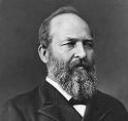 James A Garfield (1831 – 1881), twentieth President of the United States, was surrounded by support from homeopaths and he was an advocate of homeopathy all his life.
James A Garfield (1831 – 1881), twentieth President of the United States, was surrounded by support from homeopaths and he was an advocate of homeopathy all his life.
Garfield’s first cousin Silas A. Boynton was a homeopath and his doctor in his final illness, alongside Susan Edson (Ludwig M. Deppisch, The White House Physician: A History from Washington to George W. Bush, (McFarland, 30 Jul 2007). Page 78).
Eliakim Scammon was Brigadier General and Garfield’s commanding officer in the 23rd Ohio Regiment. His brother Jonathan Young Scammon instituted Chicago’s Swedenborgian Church (based on the work of Emanuel Swedenborg) of the New Jerusalem, and introduced homeopathic medicine to the Midwestern city through a new hospital. Jonathan donated ground for the Hahnemann homeopathic hospital.
This was a time when the West was wild and many of America’s Institutions were being formed at this time by politicians and donations and support from homeopaths and abolitionists were of great importance at this time.
Garfield reported a resolution to the Senate to discuss epidemic diseases and he included homeopaths therein to discuss yellow fever specifially, as homeopaths had had great success treating this disease (John Hubert Ellis, Yellow Fever & Public Health in the New South, (University Press of Kentucky, 1992). Page 73).
Homeopaths had equal success treating typhoid and many other epidemic conditions, and people were frightened of allopathic treatment of the time, and the army took to homeopathy, with people like Thomas Wentworth Higginson using the remedies in his home.
Both Garfield and his wife were particularly sympathetic to homeopathy. His first cousin, and boyhood neighbor, Silas Boynton, was a homeopathic practitioner.
In 1875 Garfield asked Boynton to consult with the physicians caring for his dying mother-in-law.
In 1881, while living in the White House, Garfield’s wife Lucretia developed malaria, and Boynton was summoned again. Boynton recommended that Mrs. Garfield, who was severely ill, be transferred to the New Jersey seashore, away from the malarious swamps that reached the backyard of the White House.
During Garfield’s final illness, his first cousin Silas Boynton and another homeopath, Susan Edson attended Garfield, but as nurses.
Dr. Susan Edson, a graduate of the Cleveland Homeopathic College, was personal physician to President Garfield.
From Ruth Tenzer Feldman, James Garfield. Garfield and his wife thought that homeopathic doctors were at least as important to medicine as allopathic doctors. When Garfield was in Congress, he supported a bill to establish equal rights in government hiring and service to both types of doctors.
But the allopathic doctors opposed the bill and it was defeated.
From John S. Haller, The History of American Homeopathy: the academic years, 1820-1935. Allopathic doctors jealously tried to defeat Garfield’s wishes to defend homeopaths in the Senate, even to the point of refusing to allow a homeopath, with 20 years of allopathic experience before his conversion to homeopathy, to practice.
Eventually General James H Barker reinstated the homeopaths and the allopathic supporters lost the day.
When Garfield was shot, the allopathic doctor Bliss refused to allow Garfield the comfort of his own doctors Susan Edson and his cousin Silas Boynton, who did however remain in attendance, and he also dismissed Garfield’s own allopathic doctor J H Baxter.
As a result the nation suffered 80 days of uncertainty and Garfield 80 days of terrible pain before he died.
President James A. Garfield was brought to Long Branch in the hope that the fresh air and quiet in Elberon might aid his recovery after being shot on July 2, 1881, an incident that left the assassin’s bullet lodged in his spine. He died here on September 19, 1881, exactly two months before his 50th birthday.
Even after Garfield’s death the allopathic doctors were refusing to accept the homeopaths offer to share facilities at the hospital established in Garfield’s name, and it was left to the women homeopaths to establish the Homeopathic Free Dispensary in Washington.
These women homeopaths were closely allied to the National Woman Suffrage Association and concerned about the possible medical abuse of the poor, they went ahead and secured the strict regulation of surgical practices.


Leave A Comment